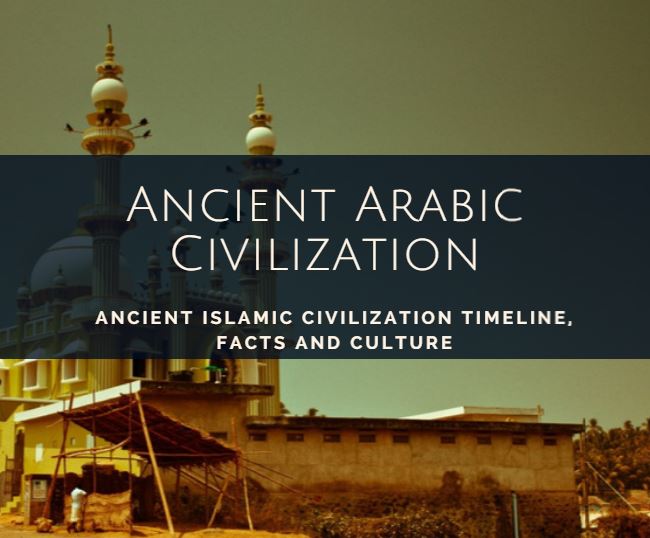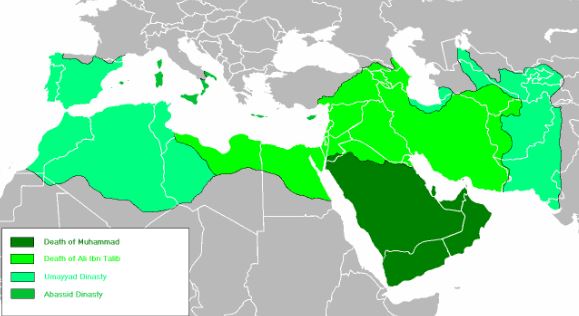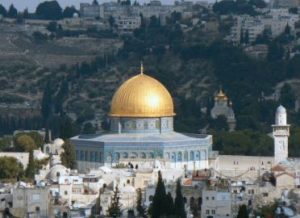The Arabian culture developed in Arabia, a peninsula situated between the Red Sea and the Persian Gulf, in southwestern Asia. Due to its arid climate, Arabia is a desert where agriculture is only possible in some coastal locations and inner oases.
The Arabian Peninsula was isolated from the great historical centers until the 7th century: it was merely a place where caravans would pass through from the East bringing spices, silks, and other goods.

Ancient Arabic Islamic Civilization
Contents
The Arabs who inhabited the peninsula were a Semitic people. Most were Bedouins: nomads who grazed goats and camels. As a result, there were few cities in Arabia; Yathrib and Mecca were the most important commercial centers.
Organized into rival tribes, the Arabs weren’t united into a country. Each tribe had its own interests and beliefs; some were fetishists; others were polytheists instead. However, most worshiped a mysterious stone: the Black Stone, in the Kaaba in Mecca. These people would spread a brilliant civilization far and wide after it was united under a common religion preached by a prophet: Muhammed.
The Birth of Islam
Muhammed was born in Mecca in 570 AD. Orphaned at an early age, as a young man, Muhammed worked in a caravan company owned by a wealthy widow called Jadicha, who he later married.
Pensive and very knowledgeable of Judaism and Christianity, Muhammed began to preach a new religion from 610. This religion recognized the existence of a single god: Allah.
At first, the inhabitants of Mecca were opposed to Muhammad’s teachings, and so in 622, they forced him to flee to the city of Yathrib, which would soon be called Medina. This journey is known as the Hegira and with it, the Islamic era began: Arabian years are counted from this date.
Shortly thereafter, Muhammad recruited an army and conquered Mecca (in 630). Most of the citizens then embraced Islam. Two years later Muhammad died, but all of Arabia was united under his teachings.

The doctrine Muhammed preached was Islam, which in Arabic means submission to God, while his followers are called Muslims. Islam is a simple doctrine, and its main tenet is faith in one God, whose prophet is Muhammed. The basic principles of this religion are established in the Muslims’ holy book, the Koran:
“Give alms to one’s brother in need.
Prayer, which must be done five times a day.
Fasting during the month of Ramadan.
The Mecca pilgrimage, at least once in one’s life.
Holy War against the infidel to defend Islam.”
Allah and the Koran
Although tradition has credited Muhammad as being devoutly pious from a very young age, Muhammad did not have his watershed religious inspiration until he was 40. At that age, tradition tells us that the archangel Gabriel imparted Allah’s revelations unto him. These revelations were delivered in intervals in rhyming prose until his death. They were then all were called the Qur’an. The Koran, which is the holy book of the Muslims, is divided into 114 chapters, called Surahs. They contain the tenets that believers must accept and the laws that form the basis of Islamic law. Among other things, the Koran prohibits drinking alcoholic beverages, eating pork, gambling, and the use of icons.
Holy War
The Koran determined Holy War to be used to spread Islam. The expansion of Islam occurred in a short space of time. In little more than a hundred years, Muhammad’s conquests spread throughout much of Asia, North Africa, and the Iberian Peninsula, where the Muslims arrived in 711.
The Road to Mecca
The Arabs built a small city at a crossroads, close to a rich spring: Mecca. In this city, there is a black stone that is venerated to this day which is associated with the father of all Arabs: Ishmael, the son of Abraham. The story goes that this stone is found in a building called the Kaaba, which means the square house. In the past, it was customary for all Muslims to make an annual pilgrimage to Mecca to visit the Kaaba. At present, every Muslim is expected come at least once in their life to the sanctuary.
Formation of the Arabic Empire
Islam united the Arabs and launched them into rapid military expansion between the 7th and 8th centuries.
When Muhammad died, leadership in Islam was exercised by caliphs – the successors of Muhammad. The first caliphs were chosen among the prophet’s relatives. Under their rule, the capital was the city of Medina and the Muslims conquered North Africa, Syria, Palestine, and the Persian Empire.

After the death of Caliph Ali (661), the Umayyad family seized the caliphate and made Damascus their capital. At this time, the Muslims conquered Morocco and the Iberian Peninsula. Their rule extended to the Indus River and Turkestan to the east.
In the middle of the 8th century, after fierce fighting, the Abbasid family displaced the Umayyads and moved the capital of the caliphate to Baghdad.
From the 10th century, Islam underwent a process of political disintegration due to religious conflicts, the emergence of independent regional dynasties in Spain, Morocco and Egypt, and Turk and Mongol invasions.
The Economy in Arabic Culture
Trade was the main uniting factor that linked the Arabic Empire. From the 8th century, Muslims dominated the Mediterranean and Indian Ocean’s maritime routes, with their extension to the Red Sea and the Persian Gulf. They also controlled the major land routes in Africa and Asia.
In this way, the Arabs took over the most precious commodities: East Asian spices, Indian precious stones, Chinese silk, and Sudanese gold and ivory. They also had the best fleet and the most active ports of their time.
The use of their own currency, the gold dinar, made the Arabs independent from the Byzantine economy. Moreover, to avoid carrying many bags of coins, Muslims devised two new methods of payment: the bill of exchange and the check.
In spite of the great importance of commerce, the main resource in Arabian culture was agriculture and it underwent remarkable development between the 8th and 10th centuries.
Agriculture mainly developed in the western areas of the Mediterranean, as the Arabs introduced new irrigation techniques there: canals, waterwheels, and many others.
They also introduced new crops, such as sugarcane, apricots, cotton, and saffron.
Imperial Administration
At the head of the enormous Islamic – or Arabic – Empire was the caliph, who was the successor of Muhammad and the representative of Allah.
The Koran entrusted the caliph with maintaining order and prohibiting evil. His authority was total in both religion and politics.
Caliphs were elected at first, but the Umayyads later made the office hereditary.
The great expansion of the empire made it necessary to create a vast administration, which was inspired by Byzantine and Persian models:
In the provinces, governors, called walis or emirs, had civil and, with time, even military authority.
In the central administration, viziers, or ministers, were in charge of the main services and worked with the caliph. In Spain, there was an intermediate figure between the caliph and vizier: the hayib, or prime minister.
For judicial administration, the caliphs appointed judges, or qadis, in every city in the empire.
The army secured great conquests: they enjoyed the benefits of excellent organization, in which cavalry was the main contingent. With the Umayyads, they recruited strictly just among Arabs. The Abbasid caliphs introduced foreigners and, after the 10th century, mercenaries.
Arabic Cities

After religion, the second hallmark of Arabic culture was their enormous urban development. Despite their nomadic origins, the Arabs quickly became accustomed to urban life. This is why, in contrast to what was happening in Christian Europe, cities flourished everywhere in Arabic culture. Arabic cities were fundamentally mercantile centers. Life there revolved around the mosque, which was where they prayed, and the souk, or market. Near the mosque was the ‘alcaicería’, where precious products from abroad were stored, and in the most important cities, there would be a mint and an exchange market. Colorful and labyrinthine shopping streets, as well as houses, intersected around this core.
Baghdad
The Abbasids moved the capital to Baghdad. From then on, Baghdad became the most splendid and populous city in the Arabic Empire, comparable only to the capital of the Byzantine Empire, Constantinople. Baghdad, the current capital of Iraq, is on the banks of the Tigris River, in a very fertile area that intersected with the great trade routes of Asia. It was, at the time, an important river port. Baghdad had two walls and was defended by 28 towers. It could be accessed through four gates located at the four cardinal points.
Arabic Culture: A Culture of Synthesis
Arabic culture assimilated different cultures from subjugated peoples. They created a culture from their own values, a mix of Eastern values (Persian, Indian, Chinese) and classical-Hellenistic traditions (taken from Byzantium)
Arabic culture added its own philosophy to this synthesis, imbued with its religion and its language, which became the universal language of the civilization, as all conquered countries adopted Arabic.
The most important works by Eastern and Greek philosophers were translated into Arabic. Based on these, Muslim scholars proceeded to make their own creations in schools and centers of learning established in large cities such as Baghdad, Damascus, and Cordoba.
Thanks to the Arabic translations, Europeans rediscovered their civilization’s old roots but also benefited from the new contributions that the Muslims had made.
Such was the case with the use of gunpowder, paper, and the compass, which they had learned from the Chinese. Passionate about alchemy, Muslim scientists discovered alcohol, potash, and sulfuric acid among other materials.
Doctors like Rhazes and Avicenna made notable advances in this science. The same thing happened with geography and astronomy. In regards to mathematics, the Arabs brought the numbering system based on zero, and algebra.
The developments thinkers like Averroes made in philosophy were also essential, as well as the diffusion of Aristotle’s philosophy, being the most widely-read author among the Arabs.
Furthermore, their literature was brilliant. Influenced by India, they nurtured short stories and tales with enthusiasm. An excellent example of this is the stories of One Thousand and One Nights, written in prose and based on stories and legends from Persia and India.
Arabic Art
Among other things, the Koran prohibited the use of religious icons. Although not all the caliphs carried out this prohibition, Arabic art was confined mainly to architecture.
The need for communal prayers on Fridays, as ordered by Muhammad, gave way to the key monument: the mosque. This was where communal prayers were performed.

In all Arabic mosques, the width is larger than the length and there are many columns, but there is no stylistic unity in the elements used (arches, capitals, decoration), which vary from country to country.
However, certain characteristics stand out:
- The use of domes, learned from Byzantium.
- The use of horseshoe arches, used by the Persians and in the Visigothic kingdom.
- The predominance of decorative elements applied to the walls: stone plates, plasterboard or glazed ceramic.
Mosques
In Arabic, mosques are called masjad, which means ‘place of worship’. Unlike Christian churches, Muslim sanctuaries are centers of prayer and not the house of God. The typical mosque was a simple courtyard, which had a wall marking Qibla, the direction facing Mecca, with a small apse, the mihrab, which indicated the direction. Then, part of this courtyard was covered and the minbar, which is the pulpit for the Imam, was added to lead prayers, while a Muslim priest called people to prayer from the minaret, a tower. To avoid idolism, Islam forbids any human or animal representation in mosques.
Dome of the Rock
The oldest surviving monument in Islam is the Mosque of Omar in Jerusalem. Built in the 7th century by the caliph Omar, Muhammad’s successor, it is also known as the Dome of the Rock. This is due to the fact that a rock is inside that is traditionally associated with the place of Isaac’s sacrifice, the son of Abraham, which is honored equally by Christians, Jews, and Muslims. Over the centuries it also became the rock from which the prophet Muhammad miraculously ascended to heaven.
